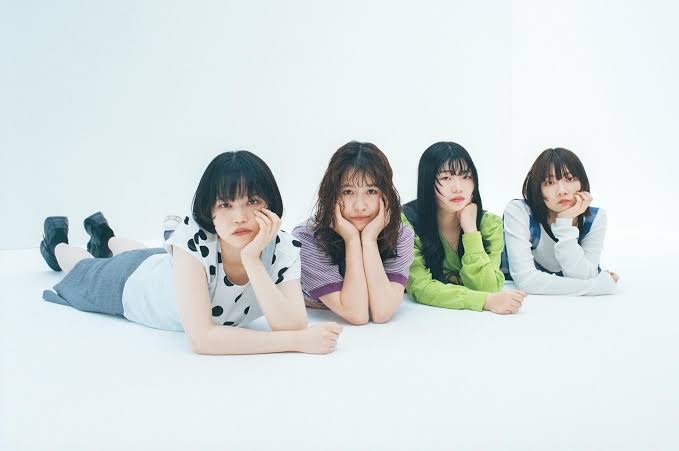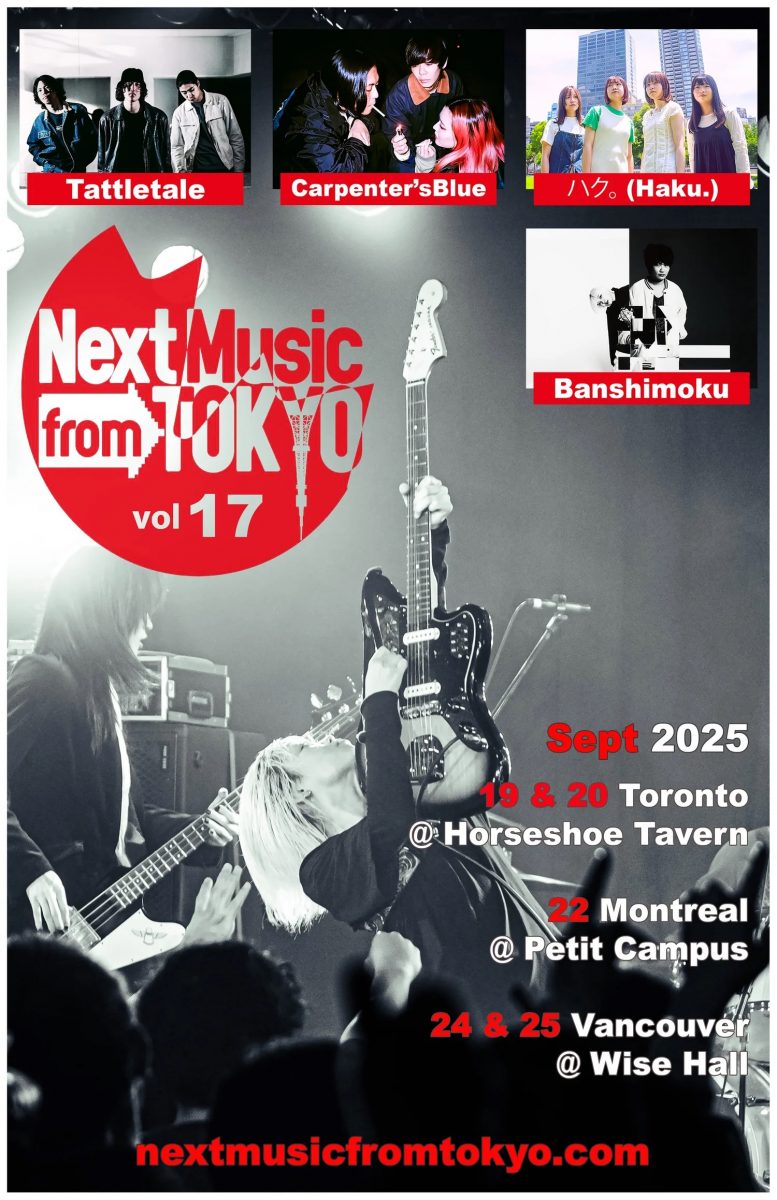Posts Tagged: japan
Haku ハク。
Who is Haku?
In 2019 Osaka Japan, four young women met at a vocational school club that teaches instruments to high school students. One of their advisors suggested that they join up to form a band and Haku was born. The circle punctuation mark at the end of Haku’s name in Japanese reflects these roots, symbolizing the “circle” where they first met. (these types of clubs are referred to as “circles” in Japan)
Haku released their first single in 2020 and by 2021 they had won the grand prize at a Kansai prefecture talent contest. Attention in Japan started to grow as the band released more music and played live shows. Haku hosts an annual “Haku Day” on August 9th, inviting their favourite musicians to play with them in Japan, drawing inspiration from their fellow artists. In their seven year career, Haku has released a steady stream of singles, EPs and two full albums. The latest EP is 2025s Catch followed by singles Minami Shinmachi and Soreshika Ienai. Soreshika Ienai marks their debut on major label Toy’s Factory. This was followed up by PataPata Cat, a web animation theme song, in October, 2025.
Recently, at the request of fans outside of Japan, Haku has begun playing international shows. They played their very first overseas show in Korea. Singapore was next and, in September 2025, Haku made their North American debut in Toronto, Canada as part of the Next Music From Tokyo showcase.
Haku lineup:

- Ai (あい) – Lead Vocals and Rhythm Guitar
- Mayu (まゆ) – Drums
- Nazuna (なずな) – Lead Guitar
- Kano (カノ) – Bass and Backing Vocals
Haku everywhere!
Largely unknown outside of Japan, Haku became famous globally with their cover of Mono No Aware’s かむかもしかもにどもかも! The catchy nonsense-lyric tongue twister was released on YouTube in Haku’s trademark vertical frame practice-session format. The popularity of the video sparked a massive social media following and requests from fans around the world for overseas live shows. Local Haku shows also began to attract foreign fans who were travelling in Japan. Fans started sending them videos of themselves mimicking Ai’s groovy dance. Below is the original video of Haku covering the Mono No Aware song. As of this writing, it has over 16 million views.
Next Music from Tokyo
Late this summer, Haku made their North American debut in Toronto, Canada at Next Music From Tokyo Volume 17.

Next Music from Tokyo is an annual showcase of young Japanese indie bands put together by Toronto anesthesiologist Steven Tanaka. Each year, Tanaka handpicks a group of bands to tour three cities in Canada over 10 days and it is always a fantastic scene. The bands give everything they have and the crowds happily take it all in, dancing and crowd surfing (Steve too)!
This year when the NMFT line-up was announced, I was surprised to see that it featured Haku. The website even issued a warning that since the massively popular band is coming, tickets will sell out faster than usual. This got my attention and I started listening to their back catalog as well as newer releases. I was happy to find that, although the viral video clip is cute and obviously popular, Haku’s original music is even better.
Haku live at the Horseshoe Tavern in Toronto, Canada
Around a year ago, Haku performed on NHK Japan and talked about influences and future goals. Ai expressed that although they were a band of 4 young girls, they did not want to be bound by the expectations of being a “girl band”. They hoped to show a more aggressive sound in live shows and to write songs that would have a broad appeal to fans of all genders and ages. With that statement in mind, it was fun to witness their first North American show in person.
From the very first song, the band delivered an energetic and gritty sound. The crowd, made up of men and women of all ages in equal number, responded with enthusiastic dancing and clapping. Surprisingly, many of their fans were singing along in Japanese to Haku’s originals. If their goal was to win over a broad spectrum of fans with high-intensity live versions of their original songs I think it was accomplished with great success. I loved the show and I was immediately sorry I didn’t buy tickets for both nights in Toronto.

Haku original music
For a band whose members are probably somewhere in their early 20s, Haku has released a good volume of music. The early singles and first mini album (Wakamono Nikki) sound like a young band still developing their identity and musical style but the playing is solid and the songwriting is good. The second full length album, Bokurajanakyadameninatte, is where the band really starts to shine and the most recent EP titled Catch showcases the fully developed Haku at their best.
The songs are bright and energetic with memorable vocal melodies and guitar hooks. They manage to sound fresh and original but somehow familiar at the same time. In the NHK interview, Ai talked about how many older fans have said that Haku’s music takes them back to their youth. She attributes this to the influence of 90s US and UK indie on Haku songwriting. These 90s flavours blended with modern J-pop and J-rock influences give Haku their defining sound and broad appeal.
Recipe for Success
Ai’s vocals are dynamic with an impressive range. Her lyrics (all in Japanese) touch on the universal topics of love and relationships with others, as well as her relationship with the world at large. Ai takes centre stage as the main vocalist and delivers crunchy rhythm playing on her 70s Telecaster Custom. She hopes to write songs that “stand the test of time” and from the enthusiasm of the live audience and the fact that they knew most these songs by heart, I think she is on the right track.
Nazuna’s guitar playing is mostly clean with an unmistakable Stratocaster chime. She sometimes doubles the rhythm guitar but more often wanders away on her own with mathematical and sweetly musical single-note lines. At NHK, she said that she wanted to invent guitar phrases that “linger in your ear”. I think that Nazuna’s guitar lines are just as catchy as Ai’s vocals and the two together create melodies that are hard to forget.
Kano is a creative bass player never lingering very long on a single note. Bass lines bounce along with the drums, counter guitar lines, experiment with harmonies and always add to the overall big energy of the song. Kano is also the second voice for doubling or vocal harmony and, in interviews, stands out as the most outgoing spokesperson for the band.
Mayu keeps it all together with breezy style. Sometimes I can hear the tight clockwork precision of The Strokes and other times her side stick syncopated rim clicks remind me of Stewart Copeland. She is a great drummer now but I think her ambition to learn and improve will sharpen her skills even more in the future.
Each player in the band brings their own unique style but it is definitely the combination of these four talents that gives Haku it’s appeal. The musicianship is undeniable and their obvious close friendship just adds to their charm.
Where to find Haku:
You can stream Haku in all the usual places.
Haku is also active on Instagram and YouTube. Click here for the Haku official website.
Haku is rumoured to be returning to Canada for Next Music From Tokyo Volume 18! Keep an eye on the NMFT website for details.
For a list of all upcoming live shows look here.
Here is the song Ai! from the Catch EP….it is a great record. Look it up on your favourite streaming platform.
A great song and video from Bokurajanakyadameninatte….
If you have any questions or comments or if I spelled anesthesiologist or anything else wrong… please share in the space below.
What’s your favourite Haku song? Leave it in the comments!
Tiara Girls in Shibuya Scramble
Smartphones and Social Media: Today’s Popular Photography
These days, everyone everywhere has a camera in their pocket. Smartphone cameras have filters, AI and editing tools that give everyone the ability to take a decent photograph. Publishing photos has also become effortless. Anyone can post their images publicly on social media platforms like Instagram, and image posts get feedback through “likes” and “comments”. This is satisfying and motivating. It is a fun way to share your images with a huge audience.
Social media gives people the motivation to take photographs and smartphone technology makes it easy. The result is that millions of personal documentary style photos are being published everyday. Photo based apps have become a worldwide tool for communication and self expression. But while casual social media snaps are by far the most common type of photography, there are still other types of photographs to consider: images that are able to draw and hold your attention, freezing unique and surprising moments in time. There is a kind of magic in them. They are rare and difficult to capture.
Because these types of photos are so elusive, netting them requires some planning and skill but mostly persistence and luck. Of the thousands of pictures I took on a recent trip to Japan and Korea, I managed to capture only one such image.
The 1/250th of a second miracle

1/250th of a second…that’s how much time is captured here. We are in a huge crowd of people swarming through Shibuya Scramble Crossing in Tokyo. I am quickly walking forward taking pictures from waist level without looking through my camera. The girls are walking quickly towards me headed in the opposite direction. For this fraction of a second, we are facing each other. We are less than 2 metres apart and my finger happens to push the camera shutter. We pass each other and the moment is gone. Forever. One fraction of a second before or after and it would not exist. It is pure luck.
The intimate angle, the fact that the image is in focus and exposed so well and the emotion on display coming together in this tiny moment is almost a miracle. To put it into context, I tried the same technique in the same crosswalk for over two hours and took over 400 pictures. Out of 400 shots, maybe 6 or 7 were usable. Of those few, this was the only one that stood out as something truly special. It made the whole process worthwhile and went beyond all my expectations. It is one of my favourite pictures that I have ever taken.
What sets this image apart?
Emotion.
Photographs that express strong emotion are the ones that draw me in . And, the most captivating images are candid photos, where the emotion is pure and unaffected, where the subject has no sense that they are being photographed.
Tiara Girls in Shibuya Scramble glows with the energy of youth: freedom, rebellion, optimism are all on display. School uniform collars are unbuttoned and ties are pulled loose. Determined eyes are gazing directly and fearlessly into the future.
The princess tiaras, the body language and the smiles on their faces hint at the kind of friendship that can only bloom when you are young and free and open hearted. It makes me think of this short story passage:
“The most important people turned up surprisingly early in life. After a certain point, she found it difficult to turn even the first page of relationships that her younger self would’ve entered with relative ease. People locked their hearts at some point in their lives, as if everyone had agreed to do so. Then they made acquaintances outside those locks, with people who would never hurt them or be hurt by them”. Choi Eunyoung “Sister, My Little Soonae”
Some of our closest and most impactful friendships are forged when we are very young: before we have had our hearts bruised enough times to start hiding them away from others. This photograph captures that time.

Candid photography and telephoto lenses (spy photography)
Are there easier ways to get this kind of picture? Why not just sit up on a staircase above the crossing with a long lens and fire away..like taking bird pictures? The answer is that if you are not down in the crowd using a lens that is close to human vision perspective, you will not capture the kind of emotion that you see here. It just won’t work. The photos will look like spy camera photos, flat and lifeless. Kind of like when they show snaps of cop surveillance photos on tv shows. You need to be inside the image. When you are photographing from a distance, the photo will feel distant.
Check out my original post about Shibuya Scramble Crossing if want to see a few more pictures from this day.
If you have any questions or comments, please leave them below. Knowing you have been here gives me the motivation to keep it up. Thanks always for stopping by : )